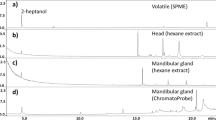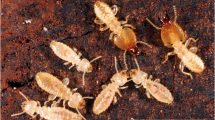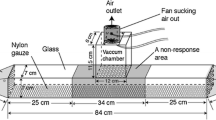Abstract
2-Nonanol, 2-heptanol, octyl decanoate, and octyl octanoate were identified from the heads ofTrigona silvestriana workers. When presented at the nest, 2-nonanol, 2-heptanol, and the mixture of the four compounds elicited angular flights, landing, and buzzing of guard bees. Octyl octanoate elicited a weaker response. No response was given to octyl decanoate, to the ether solvent, or to the control volatile, vanillin.
Similar content being viewed by others
References
Blum, M.S. 1979. Hymenopterous pheromones: Optimizing the specificity and activity of the signal,in F.J. Ritter (ed.). Chemical Ecology. Elsevier, Amsterdam.
Blum, M.S., andBrand, J.M. 1972. Social insect pheromones: Their chemistry and function.Am. Zool. 12:553–576.
Blum, M.S., Crewe, R.M., Kerr, W.E., Keith, L.H., Garrison, A.W., andWalker, M.M. 1970. Citral in stingless bees: Isolation and functions in trail-laying and robbing.J. Insect. Physiol. 16:1637–1648.
Collins, A.M., andBlum, M.S. 1982. Bioassay of compounds derived from the honeybee sting.J. Chem. Ecol. 8:463–470.
Collins, A.M., andBlum, M.S. 1983. Alarm responses caused by newly identified compounds derived from the honeybee sting.J. Chem. Ecol. 9:57–65.
Collins, A.M., Rinderer, T.E., Tucker, K.W., Sylvester, H.A., andLackett, J.J. 1980. A model of honeybee defensive behaviour.J. Apic. Res.19:224–231.
Crewe, R.M., andFletcher, D.J.C. 1976. Volatile secretions of two Old World stingless bees.S. Afr. J. Sci. 72:119–120.
Cruz, C. da Costa. 1962. Anatomia e histologia comparadas das glânduias mandibuiares dos meliponídeos. Separata dosArquivos do Museu National 52:79–84.
Free, J.B. 1961. The stimuli releasing the stinging response of honeybees.Anim. Behav. 9:193–196.
Johnso, L.K. 1974. The role of agonistic behavior in the foraging strategies ofTrigona bees. Doctoral thesis, University of California, Berkeley.
Johnson, L.K. 1980. Alarm response of foragingTrigona fulviventris (Hymenoptera: Apidae) to mandibular gland components of competing bee species.J. Kans. Entomol. Soc. 53:357–362.
Johnson, L.K., andWiemer, D.F. 1982. Nerol: An alarm substance of the stingless bee,Trigona fulviventris (Hymenoptera: Apidae).J. Chem. Ecol. 8:1167–1181.
Keeping, M.G., Crewe, R.M., andField, B.I. 1982. Mandibular gland secretions of the old world stingless bee,Trigona gribodoi Magretti: Isolation, identification, and compositional changes with age.J. Apic. Res. 21:65–73.
Kerr, W.E., Blum, M., andFales, H.M. 1981. Communication of food source between workers ofTrigona (Trigona) spinipes.Rev. Bras. Biol. 41:619–623.
Luby, J.M., Regnier, F.E., Clarke, E.T., Weaver, B.C., andWeaver, N. 1973. Volatile cephalic substances of the stingless bees,Trigona mexicana andTrigona pectoralis.J. Insect Physiol. 19:1111–1127.
Michener, C.D. 1974. The Social Behavior of the Bees. Belknap Press, Cambridge, Massachusetts.
Author information
Authors and Affiliations
Rights and permissions
About this article
Cite this article
Johnson, L.K., Haynes, L.W., Carlson, M.A. et al. Alarm substances of the stingless bee,Trigona silvestriana . J Chem Ecol 11, 409–416 (1985). https://doi.org/10.1007/BF00989552
Received:
Accepted:
Issue Date:
DOI: https://doi.org/10.1007/BF00989552




